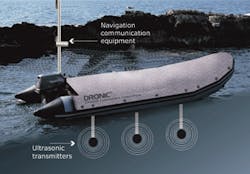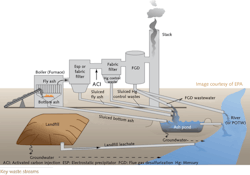Seek & Destroy: Algal Blooms
Combating Algae Blooms with Unmanned Ultrasonic Technology
Earlier this year, a European Union-backed consortium commenced work on a 30-month project to develop a robotic system that is capable of autonomously detecting and disposing of harmful algae by using an ultrasonic tool on an Unmanned Surface Vehicle (USV).
By Andrew Williams
A key objective of the "DRONIC project" is to employ a 'Master USV,' which will be used to analyse water quality and detect, localise and map algae blooms. A second USV, known as the 'Slave USV,' will then be launched to neutralise the threat, under the control of the Master USV.
The consortium, led by Netherlands-based company LG Sound, includes partners from across Europe, including ACSA and CNRS from France, SEPTENTRIO and VITO from Belgium and the Cypriot Ministry of Agriculture, as well as the University of Ljubljana and Scottish Water in the UK.
In the first stages of the DRONIC project - which is funded by the European Commission under its Seventh Framework Programme (FP7) as a research and development project with a total value of €3.2 million - the technology will be deployed at a variety of different 'end user sites,' including drinking water reservoirs owned and run by Scottish Water in the UK and the Ministry of Agriculture in Cyprus.
According to biologist Lisa Brand from LG Sound, "many new technologies" need to be developed and implemented as part of the project, with the aim being to "develop an autonomous monitoring vessel, that can monitor different water quality data and extrapolate that to a map so algae blooms can be localised, predicted and determined".
She says: "Besides that, the vessel will have an ultrasound system on board that can autonomously treat the localised algae bloom. Because these units are not stationary, the ultrasound has to be able to precipitate that algae quickly and neutralize toxins generated by the algae. For this a specific ultrasound system needs to be developed that has the right output power and frequency," she says.
Brand adds: "Because all these technologies will work autonomously, the technologies need to be integrated on an unmanned surface vessel (USV), that can navigate independently and communicate with a user on-shore."
Blooming Nuisance
According to Dr. Hans W. Paerl, Kenan Professor of Marine and Environmental Sciences at the University of North Carolina at Chapel Hill, blue-green algae are problematic because they can cause very thick growths, or 'bloom,' that can eventually lead to low oxygen problems, odours, foul tastes of affected waters and fish kills.
"They are also aesthetically unpleasant," he says. "Lastly, they produce a variety of metabolites that are toxic to animals, ranging from zooplankton that normally filter feed on algae, to fish, to mammals, including humans that drink tainted water or eat contaminated fish or shellfish." For Paerl, the early detection and mapping of blue-green algae blooms using systems like these would be "very useful" for water quality managers and researchers trying to identify the cause and possible control of such blooms.
"Furthermore, adding specific sensors for blue-green algae to drones that can distinguish them from other algal populations is useful because it can help determine if in fact there should be concerns for use-affected waters [including] drinking water, fishing and recreational use," he adds.
DRONIC Technology
LG Sound's Brand reveals that the company has been supplying products for the effective control and prevention of algae growth in lakes by using ultrasound for some time. With a treatment range of around 500 meters in diameter, these ultrasound units consist of buoys moored in the middle of a lake - and require "specific frequencies and a relatively long contact time with the algae to effectively prevent the formation of algae and effect the buoyancy of existing algae".
However, as Brand explains, in larger lakes, algae blooms are not always spread homogenously over the lake surface, but instead consist of local "hotspots" that bloom depending on waterflow, bathymetric data and nutrient levels. In order to deal with these, the company was looking for a system that could "quickly and autonomously localise these hotspots and treat them directly".
"That means we needed to develop an ultrasound system that can move towards an algae bloom, precipitate the algae and break down their metabolites," says Brand.
The new DRONIC system improves on the previous technology by using in situ water quality sensors designed to measure several variables, including Chlorophyll a, Phycocyanin, TSS, pH, Turbidity, DO, pH and temperature. In addition, Brand points out that it will also take "actual water samples during its mission and make bathymetric data to analyse depths and possible sludge layers in the reservoir".
Such measurements are carried out about every one square metre and extrapolated into a map of the lake, which will provide an overview of the lakes' water quality.
"The decision support [system] of the unit will determine where algae blooms are located in the lake. A separate USV will contain the ultrasound equipment. This vessel is instructed by the monitoring USV where to go, based on the determined algae bloom," says Brand.
"This USV is equipped with an ultrasound acoustic system that uses two different types of ultrasound. The first type will be specifically designed to create a local high pressure wave that precipitates the algae by directly affecting their buoyancy. The second type of ultrasound will be able to neutralize toxins that are produced by the blue-green algae," she adds.
Direct Application
For Brand, a key advantage of the new system is that it can be used to treat algae within the lake itself, whereas most technologies for algae control need to treat a side-stream of the water, "for example when the water and algae have already entered a treatment plant".
"Ultrasound technologies are able to control the algae in the lake itself directly, which in turn leads to a better optimised water treatment process, for example if the water is used for drinking water at a later stage," she says.
"Because the DRONIC system does not need to be placed in the lake or reservoir as a stationary unit, it can treat algae fast and specifically when it becomes a problem, even when the reservoir is large," she adds.
Moreover, Brand highlights the fact that the system could also be applied in front of the intake of a drinking water treatment plant "to locally precipitate the algae and prevent any intake of the algae".
"Mapping and monitoring the reservoir or lake provides the user with an additional advantage of having detailed information about depths of the reservoir, and thus possible sludge layers in the reservoir. It also provides an overview of the water quality in the lake, at specific locations," she adds.
Paerl agrees that the DRONIC system shows a great deal of potential and could be useful "for deciding what type of treatment to use in an impacted system, such as localized nutrient removal, flushing, use of algacides and in system biological treatment".
"DRONIC would be particularly useful in large water bodies that are not easily accessed by boat and they could be used in smaller water bodies where satellite or aircraft-based remote sensing may not be feasible or effective," he says.
Decision Support System
A key challenge facing the project team is the need to develop relatively novel technologies and systems in a number of different areas.
For example, Brand points out that a "decision support system" will need to be setup in order to enable the USV's to "locate algae blooms and also to be able to send the ultrasound USV's towards an algae bloom". This is because the types of ultrasound systems that are commonly used for algae control currently work on the basis of a low power input that affects the algae over a relatively long time span running into weeks.
"Within the DRONIC project, an ultrasonic system needs to be developed that affects the buoyancy of the algae directly when they come into contact with the ultrasound, which should also be able to switch to another ultrasonic program that can have a specific effect on the toxins produced by blue-green algae, or cyanobacteria," says Brand.
In facing up to the inevitable challenges posed by developing such novel and innovative technologies, Brand highlights the fact that the project will be executed by a consortium of expert companies throughout Europe, each with its own particular expertise.
A key partner is French outfit ACSA, which specialises in underwater positioning. It will be responsible for developing two USV's for the project that will be capable of providing enough power to the ultrasound and monitoring equipment to enable it to operate autonomously for eight consecutive hours.
Another partner in the consortium is the I3S laboratory from CNRS - a leading French research unit that will assume responsibility for developing the control system of the unit - including a decision support system that will allow the USV's to operate completely autonomously.
VITO in Belgium, a high profile research unit that have a long of experience in water quality monitoring and mapping will help with the integration of the systems, but also the visualisation of the data.
The Belgian company Septentrio, with expertise in Global Satellite Navigation Systems will provide the equipment for the DRONIC's to be able to navigate around a lake. The Slovenian University of Ljubljana will also provide the consortium with an extensive background on algae blooms, monitoring and toxin development.
********************
Dronic Project - Case Study
During early June, LG sound also announced that it had successfully carried out a project to monitor and control algae by deploying its new ultrasound-based MPC-Buoy at the 10.7 Hectare Skrzyneckie Male lake in Poznan, Poland.
As part of the project, two of LG Sounds' patented MPC-Buoys were installed at the site to provide a complete overview of the water quality - by collecting data on Chlorophyll (green algae), Phycocyanin (blue-green algae), pH-levels, total suspended solids (TSS), dissolved Oxygen levels and temperature, every 10 minutes.
This data collection exercise was important because it enabled the MPC-buoys to make use of a key innovation - namely the ability to optimise efficiency by adjusting the level of ultrasound treatment applied according to the type of algae and other parameters in the water. This treatment adjustment capability was enabled following preparatory work by consortium partner the Hellenic Centre for Marine Research (HCMR) in Greece.
LG Sound report that there was a marked difference in the algae levels between the lake treated with the MPC-buoys and several other similar lakes in the surrounding area. For example, the level of cyanobacterial (blue-green algae) cells in the nearby Kórnickie Lake was found to be nine times higher compared to the Skrzyneckie Male Lake. According to LG Sound, the MPC Buoy systems have also been used successfully at other sites in the US, Canada and Ireland - and UK drinking water company Semcorp Bournemouth Water (SBW) has recently announced a 'dramatic reduction' in the concentration of algae.
Andrew Williams is a freelance writer for WWi, specialising in environmental issues. For more info, email: [email protected]



